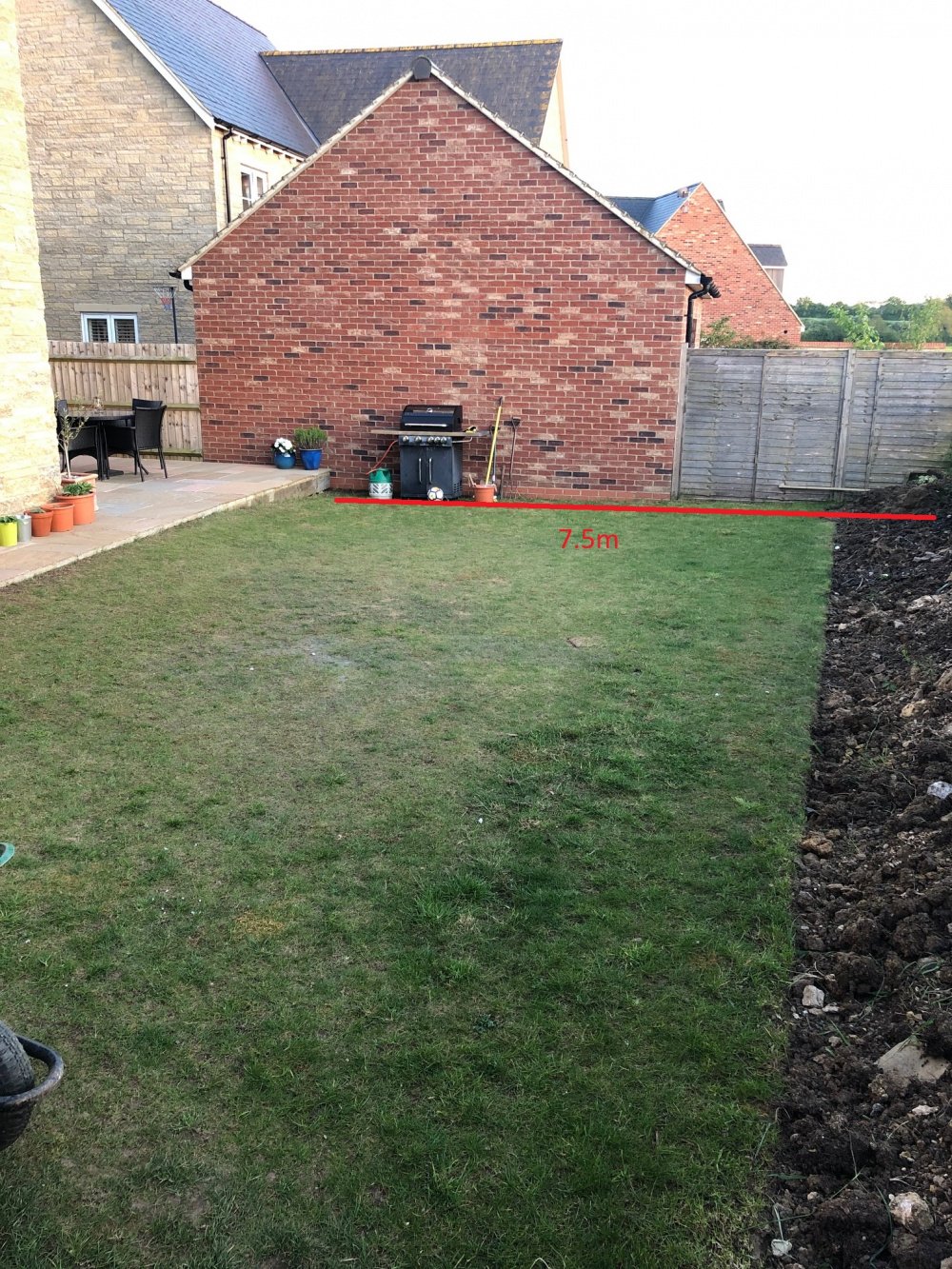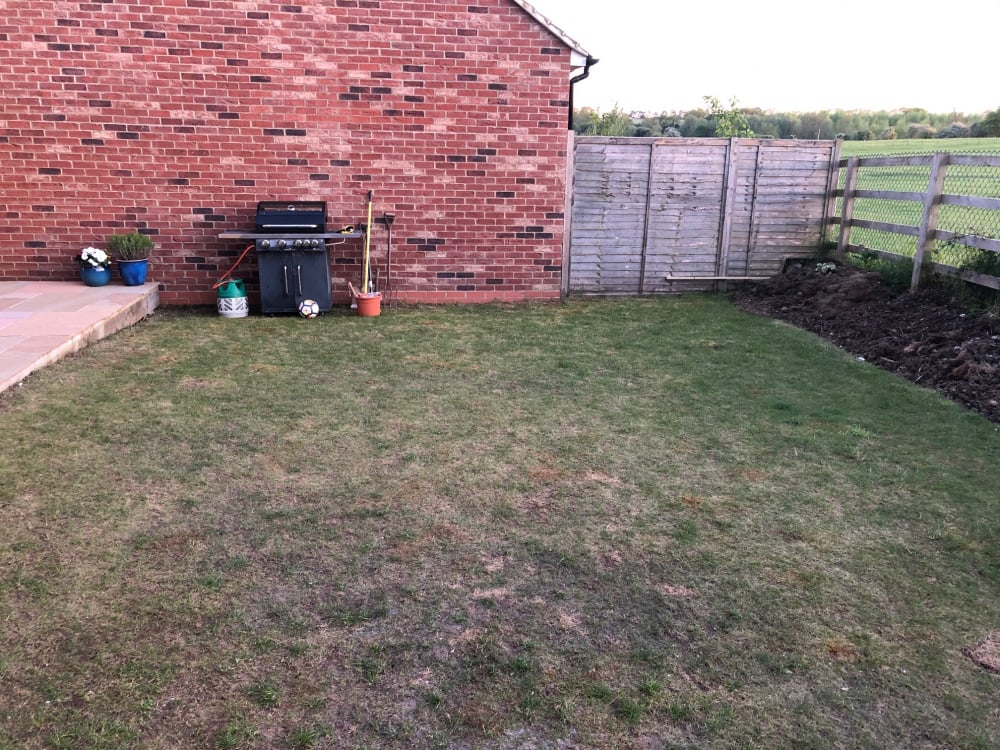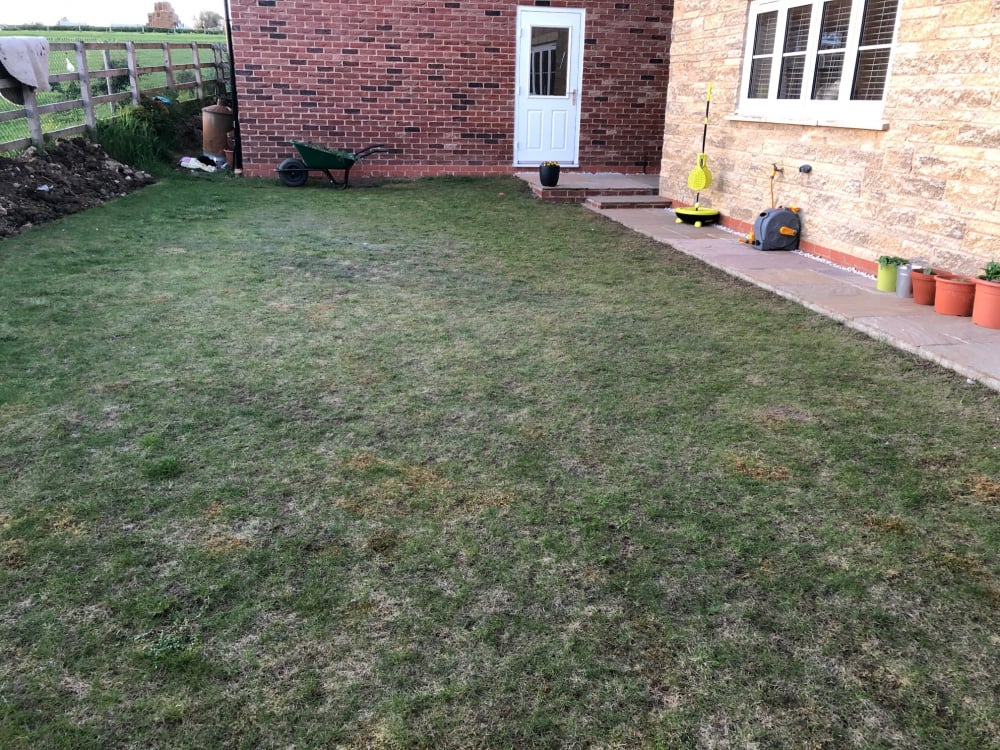This Forum will close on Wednesday 27 March, 2024. Please refer to the announcement on the Discussions page for further detail.
Lawn Levelling using sleepers for retaining element. Help/Advice.
HI All, New to the forum but have spent alot of time reading various posts when googling 'how to' in the past. I'm hoping I can tap into the knowledge base for some advice.
So the project is to level and re-turf my lawn. Its a new build with lots of debris not far under the surface and heavy clay to boot.
I have roughly 12-14" of drop from one end of the lawn to the other, which is only a total length of 12.5m.
The plan is to install sleepers across the width here...

Top of the sleeper would be flush with the patio level all the way across. You can see a small piece of timber showing roughly where that level would be. The skim the existing turf off, rotorvate the area, remove overly large rocks/debris and move around to see if I can level or if I will need to bring in more sub soil/top soil.
So my initial questions relate to the sleeper installation. I would ideally like to use 2 x 250/125mm softwood treated sleepers stack on their narrow ends. This gives me 500mm of height meaning I can dig the trench 150-200 under the existing lawn level.
In my head the steps would be as follows.
1/Dig trench, around 300mm wide all the way along
2/Use a balast/cement mix to line the bottom of the trench
3/Lay in Sleepers on narrow edge and level
4/Fix next row of sleepers using 350mm timberlock screws, maybe 3 or 4 per sleeper (2.8m length)
in theory I then have that stage finished and ready to use as a back stop for the new lawn.
Can anyone tell me anything obvious I have missed or might need to think about? Some questions I have already are,
1/350mm screws seem extreme however if the sleepers are 250mm this will give me 100mm into the next sleeper. Would I get away with 300mm screws giving me only 50mm of fix? Do I need any specialist equipment to drive home a 350mm screw through softwood treated sleepers? Assume I could pre-drill with a slightly small diamerter hole to make the screws slide in easier?
2/ Would I need to use some kind of membrane on the side of the sleepers prior to leveling the lawn and having the earth up against them?
3/ Would there be any advantage of using different dimension sleepers and stacking perhaps on the wider side rather than the narrow edge? I think fixing would be easier (as only 100/125mm to screw through) but i would need to go 4 high which might make the structure less stable?


Really appreciate any help, advice, pointers you can offer
Many Thanks,
So the project is to level and re-turf my lawn. Its a new build with lots of debris not far under the surface and heavy clay to boot.
I have roughly 12-14" of drop from one end of the lawn to the other, which is only a total length of 12.5m.
The plan is to install sleepers across the width here...

Top of the sleeper would be flush with the patio level all the way across. You can see a small piece of timber showing roughly where that level would be. The skim the existing turf off, rotorvate the area, remove overly large rocks/debris and move around to see if I can level or if I will need to bring in more sub soil/top soil.
So my initial questions relate to the sleeper installation. I would ideally like to use 2 x 250/125mm softwood treated sleepers stack on their narrow ends. This gives me 500mm of height meaning I can dig the trench 150-200 under the existing lawn level.
In my head the steps would be as follows.
1/Dig trench, around 300mm wide all the way along
2/Use a balast/cement mix to line the bottom of the trench
3/Lay in Sleepers on narrow edge and level
4/Fix next row of sleepers using 350mm timberlock screws, maybe 3 or 4 per sleeper (2.8m length)
in theory I then have that stage finished and ready to use as a back stop for the new lawn.
Can anyone tell me anything obvious I have missed or might need to think about? Some questions I have already are,
1/350mm screws seem extreme however if the sleepers are 250mm this will give me 100mm into the next sleeper. Would I get away with 300mm screws giving me only 50mm of fix? Do I need any specialist equipment to drive home a 350mm screw through softwood treated sleepers? Assume I could pre-drill with a slightly small diamerter hole to make the screws slide in easier?
2/ Would I need to use some kind of membrane on the side of the sleepers prior to leveling the lawn and having the earth up against them?
3/ Would there be any advantage of using different dimension sleepers and stacking perhaps on the wider side rather than the narrow edge? I think fixing would be easier (as only 100/125mm to screw through) but i would need to go 4 high which might make the structure less stable?


Really appreciate any help, advice, pointers you can offer
Many Thanks,
0
Posts
The levels do look to be all over the place don’t they? the level of your patio is pic one and your piece of wood the other side indicating the new level, looks like you will be building your sleepers above the dpc of your (neighbours?) brick building, if the line of newer engineering bricks below the older ones is an indication of that. You will definitely need a dpm between the wall (and fence) and the sleepers if you are butting them up against the wall. As your existing patio already exceeds this level, presumably they have tanked it on the inside there (and if they haven’t that’s their problem) but any new works carried out by you must not deleteriously affect that structure. A membrane between the sleepers and the grass is less critical, but advisable.
Compacted gravel or hardcore would be a suitable base for the sleepers rather than a hard concrete surface, as this will provide a stable enough base and allow for the natural breathing of the wooden sleepers and better drainage.
If you are drilling from the top down with 350mm screws, especially if it’s a tight screw, so to speak, you are likely to get splitting along the top face. I have a two vertical sleeper height wall forming a raised bed, joined together with sturdy metal plates and corner brackets on the inside - this, and the weight of the sleepers, holds it together sufficiently. An L or U shaped structure is much stronger than a single run. If a single run, short, external square posts banged in at intervals, bridging the vertical joins but stopping short of the top level, would make it even stronger and be hidden by the grass.
Yes laying them horizontally rather than vertically is inherently stronger, but with two vertical layers I think you will be fine. Remember to stagger the joints, whichever way you lay them.
Looking at the door/wheelbarrow end, pic 3, that could do with a bit of levelling too, plus the steep bank of soil is even more evident, so do think about retaining that whole stretch - would make a good raised bed.
Hope that helps.
OK so adjustments to plan from the comments so far would be,
1/I don't need a concrete bed, I could just use compacted type 1 sub-base and lay sleepers straight on that.
2/Laying on narrow edge would be OK as only two high however fixing with 350mm screws would probably cause splitting along the face. Alternative would be fix with metal plates on the inside (and outside?). And/Or using concreted in fence posts to fix to. I would have to have these on the 'inside' as the outside edge wouldn't allow me to get to them to fix?
3/Membrane on the inside of the sleepers is generally considered a good idea.
Other end of the garden is a headache too, ideally I want to bring that down to the level however not sure what will be under the engineering bricks of the garage? Would probably need to be two further courses exposed - Any ideas on that front? Failing that a raised bed is probably the best option as suggested.
The raised bank of earth on the right hand side will be pulled down and hopefully used to level the lawn, either entirely or partially.
Thanks again guys....
You will get weeds and such self-seeding in the gap, so maybe put a strip of dpm there and top dress with a shallow layer of gravel, which will help control that and look neater.
I assumed the field behind the soil bank was at a higher level, hence needing to retain that bit, but if the finished level of the raised lawn is roughly the same as the field that won’t be necessary. If the field does end up being higher once you have pulled the soil down, you would need to retain the soil under the existing post and rail fence.